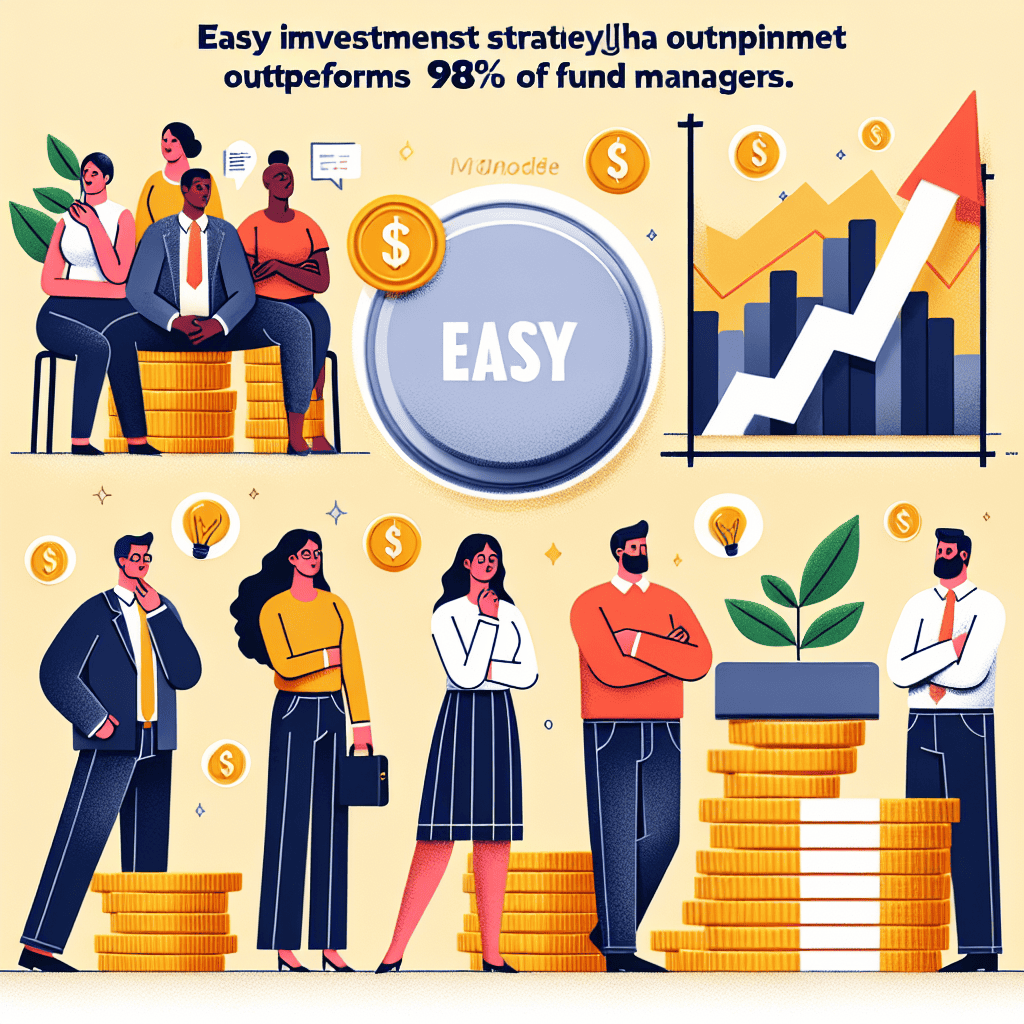“Outsmart the Experts: Achieve Top 2% Returns with This Simple Strategy!”
Introduction
In the world of investing, where complexity often reigns supreme, the allure of simplicity can be both refreshing and remarkably effective. “Beat 98% of Fund Managers with This Easy Investment Strategy” delves into a straightforward yet powerful approach that challenges the conventional wisdom of active fund management. By leveraging a strategy that prioritizes low-cost index funds and a disciplined, long-term perspective, this guide reveals how individual investors can outperform the vast majority of professional fund managers. With insights grounded in historical data and financial principles, this strategy empowers investors to take control of their financial future with confidence and ease.
Understanding The Basics Of Index Fund Investing
Investing in the stock market can often seem like a daunting task, especially when faced with the myriad of options and strategies available. However, one approach that has consistently proven to be effective is index fund investing. This strategy not only simplifies the investment process but also offers a reliable way to achieve returns that outperform the majority of actively managed funds. Understanding the basics of index fund investing is crucial for anyone looking to build a robust investment portfolio.
At its core, an index fund is a type of mutual fund or exchange-traded fund (ETF) designed to replicate the performance of a specific market index. These indices, such as the S&P 500 or the Dow Jones Industrial Average, represent a segment of the financial market and are composed of a selection of stocks that reflect the overall market’s performance. By investing in an index fund, investors essentially buy into a diversified portfolio that mirrors the index’s composition, thereby spreading risk across a wide array of assets.
One of the primary advantages of index fund investing is its cost-effectiveness. Unlike actively managed funds, which require a team of analysts and fund managers to make investment decisions, index funds follow a passive management strategy. This means that they do not attempt to outperform the market but rather aim to match its performance. As a result, index funds typically have lower expense ratios, translating to reduced fees for investors. Over time, these savings can significantly enhance an investor’s overall returns.
Moreover, index funds offer a level of simplicity and transparency that is appealing to both novice and seasoned investors. Since these funds track a specific index, investors can easily understand what they are investing in and how their investments are performing. This transparency eliminates the need for constant monitoring and analysis, allowing investors to adopt a more hands-off approach. Furthermore, the broad diversification inherent in index funds reduces the impact of individual stock volatility, providing a more stable investment experience.
In addition to cost savings and simplicity, index fund investing has a proven track record of success. Numerous studies have shown that the majority of actively managed funds fail to outperform their benchmark indices over the long term. This is due in part to the higher fees associated with active management, as well as the difficulty of consistently making accurate market predictions. By contrast, index funds, with their passive approach, have consistently delivered returns that meet or exceed those of most actively managed funds.
Transitioning to an index fund investment strategy does not require a complete overhaul of one’s financial plan. Investors can gradually incorporate index funds into their portfolios, starting with a small allocation and increasing it over time. This gradual approach allows investors to become comfortable with the strategy while still benefiting from the diversification and cost savings that index funds offer.
In conclusion, understanding the basics of index fund investing reveals a straightforward and effective strategy for achieving long-term financial goals. By embracing the principles of diversification, cost-efficiency, and passive management, investors can position themselves to beat the majority of fund managers in terms of performance. As the investment landscape continues to evolve, index funds remain a reliable and accessible option for those seeking to build wealth with confidence and ease.
The Power Of Compound Interest In Long-Term Investments
The power of compound interest in long-term investments is a concept that has captivated investors for generations, offering a pathway to financial growth that can outpace even the most skilled fund managers. At its core, compound interest is the process by which an investment grows exponentially over time, as the interest earned on the initial principal also earns interest. This seemingly simple mechanism can lead to substantial wealth accumulation, particularly when leveraged over extended periods. To understand why this strategy can outperform 98% of fund managers, it is essential to delve into the mechanics of compound interest and its implications for long-term investment success.
Initially, the impact of compound interest may appear modest, especially in the early stages of an investment. However, as time progresses, the effects become increasingly pronounced. This is due to the exponential nature of compounding, where the growth rate accelerates as the investment base expands. For instance, an investment that compounds annually at a rate of 7% will double approximately every ten years. Over several decades, this can result in a significant accumulation of wealth, far surpassing the returns typically achieved by actively managed funds.
One of the key advantages of relying on compound interest is its ability to mitigate the risks associated with market volatility. While fund managers often engage in frequent trading to capitalize on short-term market movements, this approach can lead to increased transaction costs and tax liabilities, ultimately eroding returns. In contrast, a long-term investment strategy that harnesses the power of compounding allows investors to ride out market fluctuations, focusing instead on the steady growth of their portfolio. This patience and discipline can yield superior results, as evidenced by the historical performance of broad market indices.
Moreover, the simplicity of a compound interest strategy is another factor contributing to its effectiveness. By investing in low-cost index funds or exchange-traded funds (ETFs) that track the overall market, investors can achieve broad diversification with minimal effort. This approach not only reduces the need for constant monitoring and decision-making but also minimizes the fees and expenses that can detract from long-term returns. In contrast, actively managed funds often charge higher fees, which can significantly impact net performance over time.
Furthermore, the psychological benefits of a compound interest strategy should not be underestimated. By adopting a long-term perspective, investors are less likely to be swayed by short-term market noise and emotional decision-making. This steadfast approach fosters a sense of confidence and security, allowing investors to remain focused on their financial goals without succumbing to the pressures of market timing or speculative trading.
In conclusion, the power of compound interest in long-term investments offers a compelling strategy for those seeking to outperform the majority of fund managers. By embracing the exponential growth potential of compounding, investors can achieve substantial wealth accumulation with minimal risk and effort. This approach not only provides a buffer against market volatility but also simplifies the investment process, reducing costs and enhancing overall returns. As such, individuals who harness the power of compound interest are well-positioned to achieve financial success, demonstrating that sometimes, the simplest strategies are the most effective.
How Diversification Reduces Risk In Your Portfolio
Diversification is a fundamental principle in investment strategy that can significantly reduce risk in your portfolio, offering a pathway to potentially outperforming a vast majority of fund managers. At its core, diversification involves spreading investments across various asset classes, sectors, and geographical regions to mitigate the impact of any single asset’s poor performance on the overall portfolio. This approach is grounded in the idea that a well-diversified portfolio is less susceptible to the volatility and unpredictability inherent in financial markets.
To understand how diversification reduces risk, it is essential to consider the concept of correlation. Correlation measures the degree to which two assets move in relation to each other. By investing in assets with low or negative correlations, investors can ensure that when one asset experiences a downturn, another may remain stable or even appreciate, thereby cushioning the overall portfolio from significant losses. For instance, during economic downturns, while equities might suffer, bonds often perform better as investors seek safer havens. Thus, a mix of stocks and bonds can provide a more stable return over time.
Moreover, diversification is not limited to asset classes alone. Geographic diversification is another critical aspect, as it allows investors to spread their investments across different countries and regions. This strategy can protect against country-specific risks, such as political instability or economic recessions. For example, while one country’s economy might be struggling, another’s could be thriving, balancing the portfolio’s performance. Additionally, sector diversification ensures that investments are spread across various industries, reducing the risk associated with sector-specific downturns. For instance, if the technology sector faces a downturn, investments in healthcare or consumer goods might still perform well, maintaining the portfolio’s overall health.
Furthermore, diversification can also be achieved through investment in different financial instruments, such as stocks, bonds, real estate, and commodities. Each of these instruments reacts differently to economic changes, interest rate fluctuations, and inflation, providing a buffer against market volatility. For example, real estate and commodities often serve as hedges against inflation, while bonds can offer stability during periods of economic uncertainty.
While diversification is a powerful tool for risk reduction, it is important to note that it does not guarantee against losses. Instead, it aims to optimize the risk-return trade-off by minimizing the impact of individual asset volatility on the portfolio. This strategy is particularly beneficial for long-term investors who seek steady growth rather than short-term gains. By maintaining a diversified portfolio, investors can better withstand market fluctuations and achieve more consistent returns over time.
In conclusion, diversification is a crucial strategy for reducing risk in an investment portfolio. By spreading investments across various asset classes, sectors, and geographical regions, investors can mitigate the impact of individual asset volatility and protect against market downturns. This approach not only enhances the potential for stable returns but also positions investors to potentially outperform a significant number of fund managers who may not employ such comprehensive diversification strategies. As such, embracing diversification is a prudent step for any investor seeking to build a resilient and successful portfolio.
The Benefits Of Low-Cost Investment Strategies

In the realm of investing, the allure of high returns often leads individuals to seek out complex strategies and high-cost fund managers. However, a growing body of evidence suggests that low-cost investment strategies can outperform the majority of actively managed funds. This revelation is not only reshaping the investment landscape but also empowering individual investors to achieve their financial goals with greater ease and efficiency.
To begin with, low-cost investment strategies, such as index funds and exchange-traded funds (ETFs), offer a compelling advantage through their cost-effectiveness. Traditional mutual funds often come with high management fees, which can significantly erode returns over time. In contrast, index funds and ETFs typically have lower expense ratios because they are passively managed. By tracking a specific index, these funds minimize the need for active management, thereby reducing costs. This cost advantage is crucial, as even a small difference in fees can compound over the years, leading to substantial savings and enhanced returns for investors.
Moreover, low-cost investment strategies provide a level of diversification that is difficult to achieve with individual stock picking. By investing in a broad market index, such as the S&P 500, investors gain exposure to a wide array of companies across various sectors. This diversification reduces the risk associated with investing in individual stocks, as the performance of the portfolio is not overly reliant on the success of a single company or sector. Consequently, investors can enjoy a more stable and predictable return, which is particularly beneficial in volatile market conditions.
In addition to cost savings and diversification, low-cost investment strategies offer the advantage of simplicity. The investment process is straightforward, requiring minimal time and effort from the investor. This simplicity is particularly appealing to those who may not have the expertise or desire to engage in active stock picking. By adopting a passive investment approach, individuals can focus on long-term financial goals without the stress and uncertainty that often accompany active trading. This hands-off strategy allows investors to benefit from the natural growth of the market over time, aligning with the principle that time in the market is more important than timing the market.
Furthermore, empirical studies have consistently shown that low-cost investment strategies often outperform actively managed funds. According to research, a significant percentage of active fund managers fail to beat their benchmark indices over the long term. This underperformance can be attributed to various factors, including higher fees, market inefficiencies, and the difficulty of consistently making accurate market predictions. In contrast, passive strategies that track market indices tend to deliver returns that are more consistent with the overall market performance, making them a reliable choice for long-term investors.
In conclusion, the benefits of low-cost investment strategies are manifold, offering cost savings, diversification, simplicity, and competitive returns. As more investors recognize these advantages, the shift towards passive investing continues to gain momentum. By embracing low-cost strategies, individuals can not only beat the majority of fund managers but also achieve their financial objectives with greater confidence and peace of mind. As the investment landscape evolves, the appeal of low-cost strategies is likely to endure, providing a robust foundation for wealth accumulation and financial security.
Comparing Active Vs. Passive Investment Approaches
In the world of investing, the debate between active and passive investment strategies has been a long-standing one, with each approach having its own set of proponents and critics. Active investment strategies involve fund managers making specific investments with the goal of outperforming a benchmark index. This approach requires a deep understanding of market trends, economic indicators, and individual company performance. On the other hand, passive investment strategies involve investing in a broad market index, such as the S&P 500, with the aim of replicating its performance. This method is often lauded for its simplicity and cost-effectiveness.
To understand why passive investing can often outperform active management, it is essential to consider the costs associated with each approach. Active fund managers typically charge higher fees due to the research and analysis involved in selecting stocks. These fees can significantly erode returns over time, making it challenging for active funds to consistently outperform their benchmarks. In contrast, passive funds, such as index funds or exchange-traded funds (ETFs), have lower expense ratios, allowing investors to retain more of their returns.
Moreover, the efficient market hypothesis suggests that it is difficult to consistently achieve higher returns than the overall market because all available information is already reflected in stock prices. This theory supports the idea that passive investing, which aims to match market performance, can be a more reliable strategy over the long term. Historical data further reinforces this notion, as studies have shown that a significant majority of active fund managers fail to beat their benchmark indices over extended periods.
Transitioning to the psychological aspect of investing, passive strategies also offer an advantage by reducing the emotional component of investment decisions. Active investing often involves frequent buying and selling of stocks, which can lead to impulsive decisions driven by market volatility or short-term trends. In contrast, passive investing encourages a long-term perspective, allowing investors to remain focused on their financial goals without being swayed by temporary market fluctuations.
Additionally, passive investing provides diversification benefits that are inherently built into index funds. By investing in a broad market index, investors gain exposure to a wide range of sectors and companies, reducing the risk associated with individual stock performance. This diversification can help mitigate losses during market downturns, providing a more stable investment experience.
While active investing may appeal to those who enjoy the challenge of stock picking and market timing, it is important to recognize the inherent risks and potential for underperformance. Passive investing, with its straightforward approach and lower costs, offers a compelling alternative for those seeking to build wealth over time. By embracing a passive strategy, investors can potentially outperform the majority of active fund managers, who often struggle to justify their higher fees with consistent outperformance.
In conclusion, the choice between active and passive investing ultimately depends on an individual’s financial goals, risk tolerance, and investment philosophy. However, for those looking to beat 98% of fund managers with minimal effort, passive investing presents a viable and effective strategy. By focusing on long-term growth and minimizing costs, investors can harness the power of the market to achieve their financial objectives, all while enjoying the peace of mind that comes with a disciplined and systematic approach.
The Role Of Market Efficiency In Investment Success
Market efficiency plays a pivotal role in the realm of investment success, serving as a cornerstone for understanding how to outperform the majority of fund managers. The Efficient Market Hypothesis (EMH) posits that asset prices fully reflect all available information, suggesting that it is nearly impossible to consistently achieve higher returns than the overall market through stock selection or market timing. This hypothesis is categorized into three forms: weak, semi-strong, and strong, each varying in the degree to which information is reflected in asset prices. Understanding these forms is crucial for investors aiming to leverage market efficiency to their advantage.
In the weak form of market efficiency, all past trading information is already incorporated into stock prices. This implies that technical analysis, which relies on historical price and volume data, is unlikely to yield consistent excess returns. Consequently, investors who rely solely on past price movements to make investment decisions may find themselves at a disadvantage. Transitioning to the semi-strong form, this level of efficiency asserts that all publicly available information is reflected in stock prices. As a result, fundamental analysis, which involves evaluating a company’s financial statements, industry position, and economic factors, may also prove insufficient for consistently outperforming the market. Finally, the strong form of market efficiency suggests that all information, both public and private, is accounted for in stock prices. In such a scenario, even insider information would not provide an edge, rendering any attempt to beat the market futile.
Given these insights into market efficiency, one might wonder how it is possible to outperform the majority of fund managers. The answer lies in adopting a passive investment strategy, such as investing in index funds or exchange-traded funds (ETFs) that track a broad market index. These investment vehicles are designed to mirror the performance of a specific index, such as the S&P 500, by holding a diversified portfolio of stocks that comprise the index. By doing so, investors can achieve market returns without the need for active management, which often incurs higher fees and expenses.
Moreover, empirical evidence supports the notion that passive investing can indeed outperform active management. Numerous studies have demonstrated that a significant proportion of actively managed funds fail to beat their benchmark indices over the long term. This underperformance can be attributed to several factors, including higher management fees, transaction costs, and the inherent difficulty of consistently making accurate market predictions. In contrast, passive investment strategies benefit from lower costs and the ability to capture the overall market’s performance, aligning with the principles of market efficiency.
Furthermore, the role of market efficiency in investment success is underscored by the concept of risk-adjusted returns. While active managers may occasionally achieve higher returns, these gains often come with increased risk. Passive strategies, on the other hand, offer a more stable risk-return profile by diversifying across a broad range of assets. This diversification reduces the impact of individual stock volatility, providing investors with a more consistent and reliable path to wealth accumulation.
In conclusion, understanding the role of market efficiency is essential for investors seeking to outperform the majority of fund managers. By recognizing the limitations of active management and embracing passive investment strategies, individuals can harness the power of market efficiency to achieve superior long-term returns. This approach not only aligns with the principles of the Efficient Market Hypothesis but also offers a practical and cost-effective means of navigating the complexities of the financial markets.
Steps To Implementing A Simple Investment Strategy
To effectively implement a simple investment strategy that can outperform 98% of fund managers, it is essential to understand the foundational principles that drive successful investing. The first step involves embracing the concept of passive investing, which is rooted in the belief that markets are generally efficient over the long term. This approach contrasts with active management, where fund managers attempt to outperform the market through stock selection and market timing. By adopting a passive strategy, investors can benefit from the overall growth of the market without incurring the high fees and risks associated with active management.
The cornerstone of this strategy is investing in low-cost index funds or exchange-traded funds (ETFs) that track major market indices such as the S&P 500. These funds offer broad market exposure, diversification, and lower expense ratios compared to actively managed funds. By investing in an index fund, you essentially own a small piece of every company within that index, thereby reducing the risk associated with individual stock volatility. Moreover, the low fees associated with index funds mean that more of your money is working for you, compounding over time.
Once you have decided to invest in index funds, the next step is to determine your asset allocation. Asset allocation refers to the distribution of your investment portfolio across different asset classes, such as stocks, bonds, and cash. This decision should be based on your risk tolerance, investment goals, and time horizon. A common rule of thumb is to subtract your age from 100 to determine the percentage of your portfolio that should be allocated to stocks, with the remainder in bonds. However, this is merely a guideline, and individual circumstances may warrant adjustments.
After establishing your asset allocation, it is crucial to maintain discipline through regular contributions and rebalancing. Consistently investing a fixed amount of money at regular intervals, a practice known as dollar-cost averaging, can help mitigate the impact of market volatility. This approach ensures that you buy more shares when prices are low and fewer when prices are high, ultimately reducing the average cost per share over time. Additionally, periodic rebalancing of your portfolio is necessary to ensure that your asset allocation remains aligned with your investment objectives. This involves selling assets that have appreciated and buying those that have underperformed, thereby maintaining your desired risk profile.
Furthermore, it is important to adopt a long-term perspective and resist the temptation to react to short-term market fluctuations. Emotional decision-making can lead to poor investment choices, such as selling during market downturns or chasing performance during bull markets. By maintaining a long-term focus, you can ride out market volatility and benefit from the compounding growth of your investments over time.
In conclusion, implementing a simple investment strategy that can outperform the majority of fund managers involves embracing passive investing through low-cost index funds, determining an appropriate asset allocation, and maintaining discipline through regular contributions and rebalancing. By adhering to these principles and maintaining a long-term perspective, investors can achieve their financial goals while minimizing risk and costs. This straightforward approach not only simplifies the investment process but also leverages the inherent efficiency of the markets to deliver superior returns over time.
Q&A
1. **What is the core strategy discussed?**
– The core strategy involves investing in low-cost index funds, particularly those that track the S&P 500, to achieve returns that outperform most actively managed funds.
2. **Why do index funds outperform most fund managers?**
– Index funds often outperform due to their low fees, broad market exposure, and the difficulty active managers have in consistently beating the market after accounting for costs.
3. **What are the benefits of low-cost index funds?**
– Benefits include diversification, lower fees, tax efficiency, and the ability to match market returns, which historically outperform most active managers over the long term.
4. **How does compounding affect this strategy?**
– Compounding allows returns to generate additional earnings over time, significantly increasing wealth when invested in index funds over the long term.
5. **What role do fees play in investment returns?**
– High fees can erode investment returns significantly over time, making low-cost index funds more attractive as they retain more of the investor’s returns.
6. **What is the recommended investment horizon for this strategy?**
– A long-term investment horizon is recommended, as it allows investors to ride out market volatility and benefit from the compounding of returns.
7. **How does this strategy compare to active management in terms of risk?**
– This strategy typically involves less risk than active management due to diversification and the avoidance of manager-specific risks, though it still carries market risk.
Conclusion
The conclusion of the article “Beat 98% of Fund Managers with This Easy Investment Strategy” likely emphasizes the effectiveness and simplicity of the proposed strategy in outperforming the majority of professional fund managers. It may highlight the benefits of low-cost index investing, such as reduced fees, diversification, and consistent long-term returns, which can lead to better performance compared to actively managed funds. The conclusion might also stress the importance of discipline, patience, and a long-term perspective in achieving investment success, encouraging investors to adopt this straightforward approach to potentially enhance their financial outcomes.





